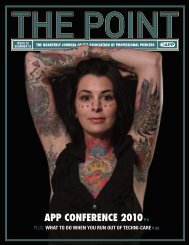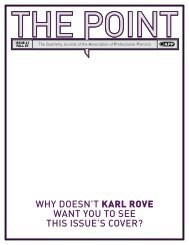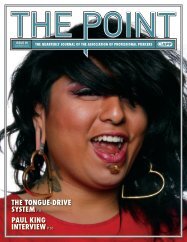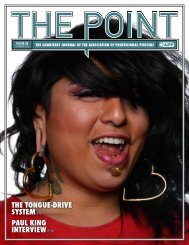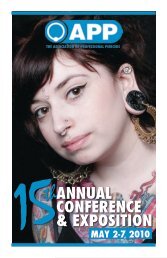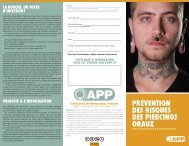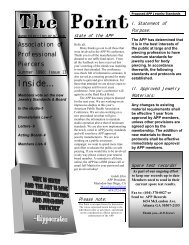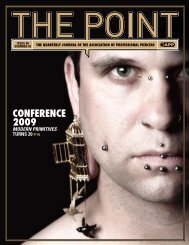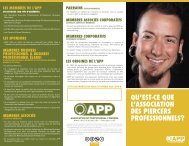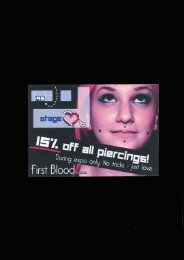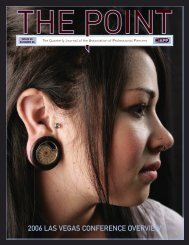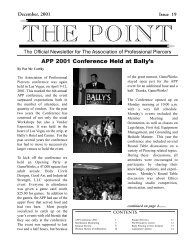the point - Association of Professional Piercers
the point - Association of Professional Piercers
the point - Association of Professional Piercers
You also want an ePaper? Increase the reach of your titles
YUMPU automatically turns print PDFs into web optimized ePapers that Google loves.
<strong>the</strong> jewelry moves too freely and bacteria can get trapped inside<br />
<strong>the</strong> piercing. Any bacteria such as Pseudomonas or Staphylococcus<br />
live on our body every day. It does however become extremely<br />
problematic when introduced into <strong>the</strong> body. In <strong>the</strong>se situations<br />
(no matter who or where <strong>the</strong> piercing was done) <strong>the</strong>se people ended<br />
up with very serious infections that settled within 24-48 hours<br />
<strong>of</strong> <strong>the</strong> piercing. Some requiring hospitalization and some not.<br />
In two years we came up with <strong>the</strong> following suggestions:<br />
Know your anatomy. Ear cartilage is firm but flexible and <strong>the</strong>re<br />
are different types <strong>of</strong> it. Not all tissue is <strong>the</strong> same. Its blood<br />
supply is very poor and it can be easily damaged which is a very<br />
irreversible problem.<br />
Never use clamps when piercing ear cartilage. This pressure can<br />
shatter <strong>the</strong> tissue and when nothing is supporting <strong>the</strong> exit <strong>of</strong> <strong>the</strong><br />
needle, an opposite pressure is created, which bows <strong>the</strong> tissue in<br />
<strong>the</strong> cartilage itself.<br />
Aftercare must be known. Every piercer must educate <strong>the</strong>mselves<br />
to <strong>the</strong> affects <strong>of</strong> chemicals on healing tissue. Antimicrobial<br />
products are not always <strong>the</strong> answer and can be very harsh to <strong>the</strong><br />
granulating tissue. Sea salt soaks must be done appropriately (not<br />
with eye contact solutions that are meant for lenses in your eye,<br />
unlike a healing wound). These soaks should be done at least<br />
three times a day for initial healing for a minimum <strong>of</strong> 5 minutes<br />
and no longer than 10 minutes. If under 5 minutes, <strong>the</strong> warmth<br />
<strong>of</strong> <strong>the</strong> water and salt cannot bring or increase <strong>the</strong> blood supply<br />
to <strong>the</strong> area. Over 10 minutes, <strong>the</strong> blood vessels that have dilated<br />
due to <strong>the</strong> heat <strong>of</strong> <strong>the</strong> water have adjusted and are no longer being<br />
beneficial. After <strong>the</strong> salt soaks, clients must wipe <strong>of</strong>f <strong>the</strong> residual<br />
salt water with a gauze pad and not a Kleenex that has been sitting<br />
in <strong>the</strong>ir bathroom. The client should be aware <strong>of</strong> how bacteria is<br />
transmitted through every day items including bed sheets, pillowcases,<br />
hair, styling products, telephones, etc.<br />
In conclusion, as a piercer I have seen less complications come<br />
from ear cartilage piercings done at half gauge larger than with<br />
same gauge needles. There will always be problems due to inappropriately<br />
followed aftercare technique related to ei<strong>the</strong>r <strong>the</strong> client<br />
or uninformed piercers. There have been multiple lawsuits<br />
with ear cartilage piercings that have caused permanent deformities<br />
on clients. The problem with most <strong>of</strong> <strong>the</strong>se cases is that <strong>the</strong><br />
piercer could not show pro<strong>of</strong> <strong>of</strong> why <strong>the</strong>y do what <strong>the</strong>y do with<br />
<strong>the</strong>ir techniques. There are organizations such as The <strong>Association</strong><br />
<strong>of</strong> Pr<strong>of</strong>essional <strong>Piercers</strong>, which is recognized as an expert in <strong>the</strong>ir<br />
area. <strong>Piercers</strong> need to get involved with <strong>the</strong>se organizations that<br />
can provide <strong>the</strong>m with appropriate ongoing education.<br />
In <strong>the</strong> past decade, piercing has gone from an underground<br />
art to an industry both regulated and recognized by our government.<br />
We have to realize that even a bookkeeper must have<br />
ongoing education, what makes our industry any different? So<br />
many people in our community like to use titles such as “Master<br />
Piercer”. The best thing that I have ever heard was from somebody<br />
who I would personally consider a “Master” which was,<br />
“The learning is never finished”. That is something that every<br />
one <strong>of</strong> us should take to heart. There is always room to grow and<br />
learn from somebody else.<br />
PRESS RELEASE<br />
SUMMARY OF MED-PIERCE<br />
& THE EMERGENCY BODY PIERCING<br />
JEWELRY REMOVAL KIT<br />
Scott DeBoer RN,MSN<br />
Flight Nurse: University <strong>of</strong> Chicago Hospitals<br />
Medical Consultant: <strong>Association</strong> <strong>of</strong> Pr<strong>of</strong>essional <strong>Piercers</strong><br />
Owner: Med-Pierce<br />
www.Med-Pierce.com<br />
scott@peds-r-us.com<br />
Troy Amundson EMT-B<br />
Pr<strong>of</strong>essional Body Piercer: Apocalypse Piercing, Seattle WA<br />
Senior Consultant: Med-Pierce<br />
www.apocalypsetattoo.com<br />
www.Med-Pierce.com<br />
piercertroy@yahoo.com<br />
WWW.MED-PIERCE.COM<br />
1-219-864-4681<br />
A recent study showed that 51% <strong>of</strong> college students had<br />
something pierced beyond <strong>the</strong>ir ears! As hundreds <strong>of</strong> thousands<br />
<strong>of</strong> piercings are being done in <strong>the</strong> United States each<br />
year, medical pr<strong>of</strong>essionals will be caring for pierced patients.<br />
Understanding <strong>the</strong> medical issues associated with body modifications<br />
as well as safe removal techniques are essential for all<br />
healthcare pr<strong>of</strong>essionals. This kit not only provides <strong>the</strong> training<br />
but also <strong>the</strong> pr<strong>of</strong>essional equipment needed for quick and safe<br />
removal <strong>of</strong> most body jewelry.<br />
Our kit is designed to help dispel many <strong>of</strong> <strong>the</strong> “medical myths”<br />
and present <strong>the</strong> “research realities” regarding body jewelry removal<br />
and o<strong>the</strong>r associated issues for <strong>the</strong> medical community.<br />
This complete training kit is unique in that it not only provides a<br />
summary <strong>of</strong> <strong>the</strong> medical research and necessary tools, but also<br />
<strong>the</strong> “piercer’s perspective” on removal techniques through our<br />
“live models,” step-by-step full color guide, and videos.<br />
• Step-By-Step Body Piercing Jewelry Removal Video<br />
for Medical Pr<strong>of</strong>essionals (20-minute demonstration video)<br />
• Tattoos, Teens, Tongues & Trauma<br />
(60-minute presentation video)<br />
• Small & Large Removal Pliers<br />
(surgical instrument grade 410 stainless steel)<br />
• Step-By-Step Body Piercing Jewelry Removal Handbook<br />
(fully illustrated)<br />
• Samples (several <strong>of</strong> <strong>the</strong> most common types <strong>of</strong> body jewelry)<br />
ISSUE 35 T H E P O I N T 9




